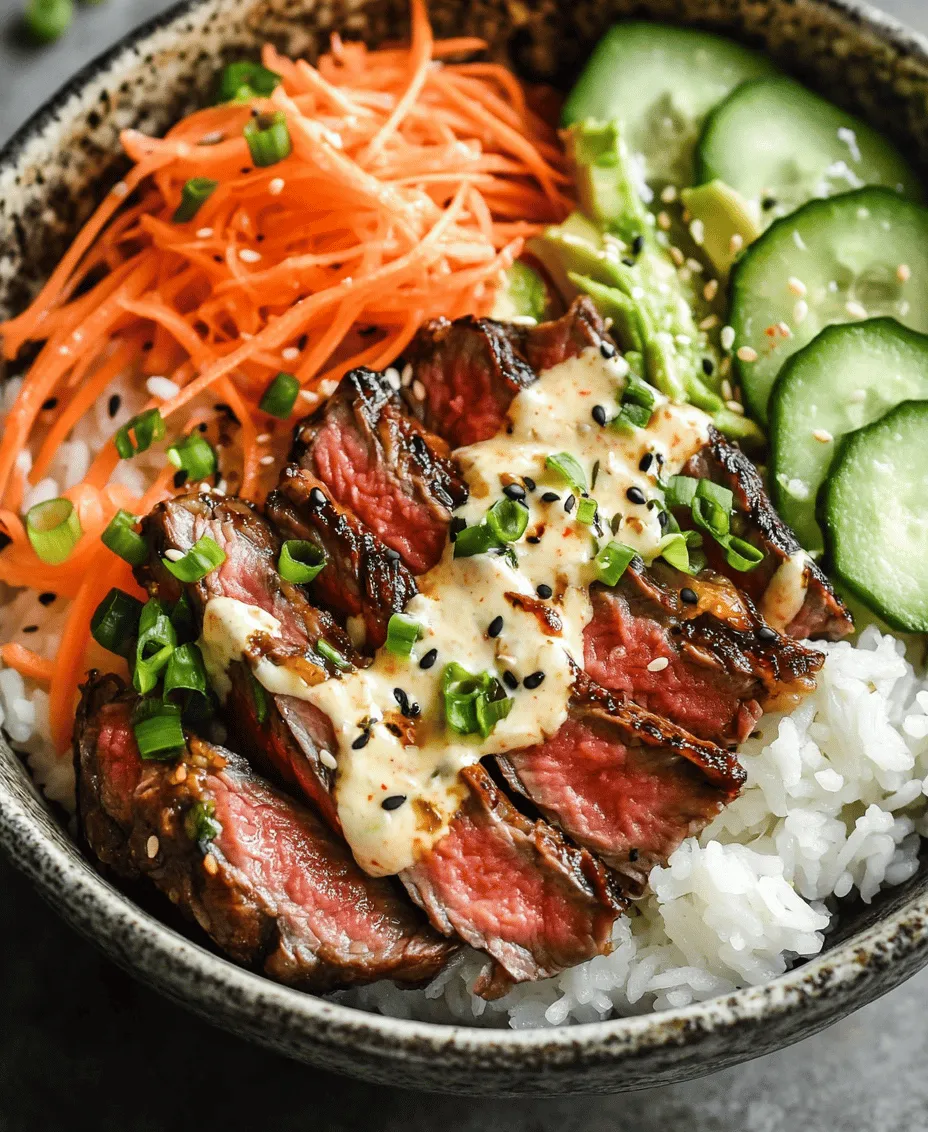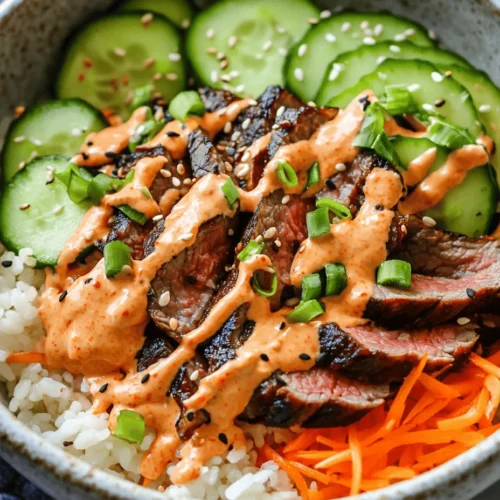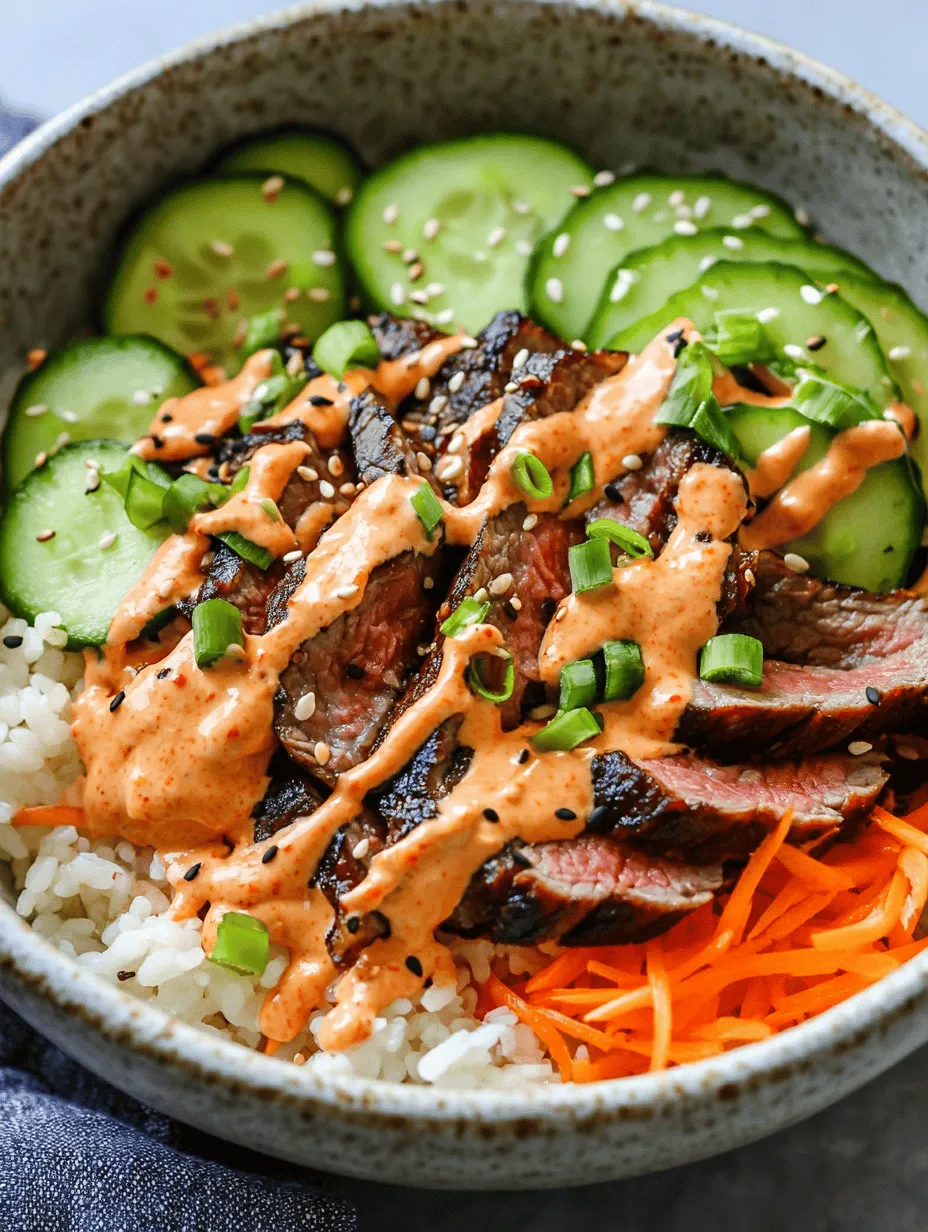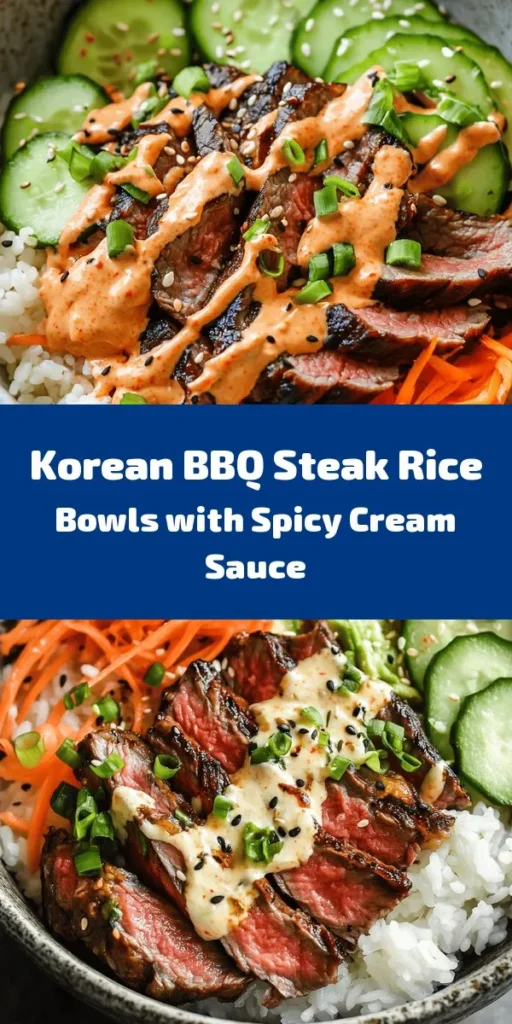Introduction
Korean cuisine has garnered immense popularity worldwide, renowned for its dynamic flavors, rich textures, and colorful presentations. This culinary tradition beautifully blends spicy, sweet, and savory elements, making it a favorite among food enthusiasts. One standout dish that encapsulates the essence of Korean flavors is the Korean BBQ Steak Rice Bowl with Spicy Cream Sauce. This dish not only celebrates the vibrant taste of marinated steak but also brings together a medley of fresh vegetables and aromatic rice, all topped with a luscious sauce that adds a unique twist.
What makes Korean BBQ Steak Rice Bowls particularly appealing is their versatility. They are perfect for a quick weeknight dinner when time is of the essence, yet they also shine as a centerpiece for gatherings and celebrations. The harmonious balance of flavors and textures in this dish ensures that it caters to diverse palates, making it an ideal choice for both casual meals and special occasions. The use of fresh ingredients, paired with a carefully crafted marinade, elevates this dish, providing a satisfying and health-conscious meal option.
Understanding the Key Ingredients
To create an unforgettable Korean BBQ Steak Rice Bowl, it is essential to focus on the quality and freshness of the ingredients. Each component plays a pivotal role in the overall flavor profile and nutritional value of the dish. Here’s a closer look at the key ingredients that will bring this recipe to life.
Flank Steak or Ribeye
The choice of meat is fundamental in crafting a delicious rice bowl. Flank steak and ribeye are two excellent options that offer distinct textures and flavors. Flank steak is lean with a rich, beefy taste, making it a popular choice for marinating and grilling. On the other hand, ribeye boasts a higher fat content, contributing to its tenderness and juiciness. Both cuts absorb marinades beautifully, ensuring the meat is flavorful and succulent after cooking.
When preparing your Korean BBQ Steak Rice Bowls, consider the method of cooking as well. Grilling, broiling, or pan-searing these cuts will enhance their natural flavors, giving that sought-after charred exterior.
Gochujang
Gochujang, a staple in Korean cooking, is a fermented red chili paste that brings a depth of flavor and a hint of heat to dishes. The unique umami profile of gochujang is essential in this recipe, as it not only enhances the marinade but also adds complexity to the spicy cream sauce. This ingredient is packed with flavor, and its slightly sweet undertones make it a perfect complement to the savory notes of the steak.
When using gochujang, it’s important to consider the spice tolerance of your guests, as its heat can vary. Adjusting the quantity of gochujang in the marinade and sauce allows you to customize the dish to your liking.
Jasmine Rice
For the base of the rice bowl, jasmine rice is the preferred choice. Known for its delicate floral aroma and slightly sticky texture, jasmine rice pairs wonderfully with the bold flavors of Korean BBQ. The rice serves as a neutral canvas, soaking up the juices from the marinated steak and the spicy cream sauce, creating a delightful harmony of flavors in each bite.
When cooking jasmine rice, it’s essential to rinse it thoroughly before cooking to remove excess starch, resulting in a lighter, fluffier texture. This step will enhance the overall experience of your rice bowl.
Fresh Vegetables
Fresh vegetables are not just a colorful addition; they also contribute vital nutrients and textural contrast to the dish. Commonly used vegetables in Korean BBQ Steak Rice Bowls include cucumbers, carrots, kimchi, and avocado.
– Cucumber: Adds a refreshing crunch and balances the heat from the gochujang and spicy cream sauce.
– Carrots: Their natural sweetness and crisp texture complement the savory flavors of the steak.
– Kimchi: This fermented vegetable dish brings a tangy flavor and probiotic benefits, enhancing the overall healthiness of the meal.
– Avocado: While not traditional, avocado provides creaminess and healthy fats, enriching the dish with a smooth texture.
Incorporating a variety of vegetables not only boosts the nutritional value but also adds visual appeal, making the rice bowl a feast for the eyes as well as the palate.
Spicy Cream Sauce
The spicy cream sauce is the crowning glory of the Korean BBQ Steak Rice Bowl. This fusion of flavors marries the heat of gochujang with creamy elements, creating a sauce that elevates the entire dish. The creaminess helps to temper the spice, resulting in a well-rounded flavor profile.
When crafting the spicy cream sauce, consider the balance between the creamy and spicy components. You can experiment with various dairy products, such as sour cream, yogurt, or even coconut cream, to achieve your desired consistency and taste. This sauce not only adds depth to the dish but also personalizes each bowl, allowing for an exciting culinary experience.
Marinating the Steak: A Crucial Step
Marination is a critical step in preparing the steak for your rice bowls. It not only infuses the meat with flavor but also enhances its tenderness, ensuring a juicy and flavorful bite in every serving.
The Marination Process
To achieve the perfect marinated steak, start by combining the marinade ingredients in a bowl. A typical marinade for Korean BBQ includes soy sauce, sesame oil, minced garlic, and grated ginger. Each ingredient plays a significant role:
– Soy Sauce: Provides a savory, salty base that penetrates the meat, enhancing its natural flavors.
– Sesame Oil: Adds a nutty aroma and richness, complementing the other flavors in the marinade.
– Garlic: Imparts a robust, aromatic quality that elevates the overall taste.
– Ginger: Contributes a hint of warmth and spiciness, balancing the flavors of the marinade.
Once the marinade is prepared, slice the flank steak or ribeye against the grain for maximum tenderness. Submerge the meat in the marinade, ensuring it is well-coated. Cover the dish and refrigerate for at least 30 minutes, though marinating for a few hours or even overnight will yield the best results.
Recommended Marination Time
The recommended marination time can vary based on personal preference and the cut of meat. For flank steak, a minimum of 30 minutes is essential, but for optimal flavor penetration, aim for 2 to 4 hours. If you have the time, marinating overnight will enhance the flavor even more, allowing the ingredients to meld beautifully.
By investing time in this crucial step, you ensure that your Korean BBQ Steak Rice Bowls boast mouthwatering flavor and tenderness that will impress your family and friends.
Preparing the Spicy Cream Sauce
The spicy cream sauce is the ingredient that ties all the elements of the Korean BBQ Steak Rice Bowls together. A well-crafted sauce can elevate the dish, providing a burst of flavor that complements the marinated steak and fresh vegetables.
Step-by-Step Preparation of the Sauce
To prepare the spicy cream sauce, start with your choice of cream base, such as sour cream or Greek yogurt. In a mixing bowl, combine the cream base with gochujang, lime juice, and a pinch of sugar to balance the heat.
– Cream Base: The creaminess provides a rich texture that helps to mellow the heat from the gochujang.
– Gochujang: The star ingredient, lending both spice and depth to the sauce.
– Lime Juice: Adds acidity, brightening the flavors and providing a refreshing contrast.
– Sugar: A touch of sweetness helps to round out the spice, making the sauce more palatable.
Mix these ingredients until smooth, adjusting the spice levels to your liking. If you prefer a milder sauce, reduce the amount of gochujang. Conversely, for those who enjoy an extra kick, feel free to add more.
Tips for Adjusting Spice Levels
When preparing the spicy cream sauce, keep in mind that the heat can vary significantly depending on the brand of gochujang used. It is advisable to start with a smaller amount and taste as you go, gradually increasing until you reach your desired level of spiciness.
Additionally, if you find the sauce too spicy, consider adding more of the creamy base to dilute the heat without sacrificing flavor. This versatility allows you to cater to different palates and ensures that everyone can enjoy your Korean BBQ Steak Rice Bowls.
By focusing on fresh ingredients, proper marination, and a well-balanced sauce, you will create a dish that showcases the best of Korean flavors while providing a satisfying and nutritious meal. As you prepare to assemble your rice bowls, remember that the joy of cooking lies in experimentation and personal touches, so feel free to customize the recipe to suit your tastes.

Cooking the Steak to Perfection
Cooking the steak for your Korean BBQ Steak Rice Bowls is a critical step that can elevate your dish from good to exceptional. The two best cooking methods for achieving that perfect sear and flavorful crust are using a grill pan or a skillet.
Best Cooking Methods: Grill Pan vs. Skillet
A grill pan is ideal for mimicking the authentic char of traditional Korean BBQ. Its raised ridges allow for excellent browning while keeping the steak elevated from excess grease. If you opt for a skillet, choose cast iron for its superior heat retention, which can create a beautiful crust on the steak. Both methods will yield delicious results, but your choice may depend on the equipment you have available.
Tips for Achieving the Desired Doneness
The key to a perfectly cooked steak lies in the internal temperature. Here are some quick tips to achieve your desired doneness:
– Rare: 125°F (52°C) – Bright red center
– Medium Rare: 135°F (57°C) – Warm red center
– Medium: 145°F (63°C) – Pink center
– Medium Well: 150°F (66°C) – Slightly pink center
– Well Done: 160°F (71°C) and above – No pink
Use a meat thermometer to check the temperature accurately. Start by searing the steak on high heat for about 2-3 minutes per side, then reduce the heat to medium and continue cooking until you reach your desired temperature.
Importance of Letting the Steak Rest Before Slicing
Once your steak is cooked to perfection, do not slice it immediately. Letting it rest for at least 5 to 10 minutes allows the juices to redistribute throughout the meat, resulting in a more flavorful and tender bite. Cover it loosely with foil during this time to keep it warm.
Assembling the Rice Bowls
Assembling your rice bowls is where the magic happens. This is not just about piling ingredients together; it’s an art form that highlights the flavors and textures of each component.
Step-by-Step Guide to Assembling the Bowls
1. Start with the Base: Begin by placing a generous scoop of cooked rice at the bottom of each bowl. Short-grain rice is traditional, but you can use jasmine or brown rice if preferred.
2. Add the Steak: Once your steak has rested, slice it against the grain into thin strips and layer it on top of the rice.
3. Layer in the Vegetables: Incorporate your choice of fresh vegetables such as julienned carrots, cucumber slices, and shredded cabbage. This adds crunch and freshness, balancing the rich flavors of the steak.
4. Drizzle the Spicy Cream Sauce: Generously drizzle your spicy cream sauce over the top, allowing it to cascade down the ingredients, infusing every layer with its tangy heat.
5. Final Touches: Finish with a sprinkle of sesame seeds and finely chopped green onions for a burst of color and flavor.
Importance of Layering Flavors and Textures
Layering not only enhances the visual appeal of your dish but also creates a delightful mix of flavors and textures in each bite. The creaminess of the sauce, the umami of the steak, the crunch of fresh vegetables, and the softness of rice work together to create a harmonious eating experience.
Suggestions for Presentation and Garnishing
To elevate the presentation, consider using bowls with contrasting colors. A dark bowl can make the vibrant colors of the vegetables pop. You can also garnish with additional elements like microgreens or edible flowers for a touch of elegance.
The Role of Accompaniments
No Korean BBQ dish is complete without its traditional accompaniments, which play a significant role in enhancing the overall meal experience.
Discussion on Traditional Korean Accompaniments to the Dish
Korean cuisine prides itself on balance, and accompaniments like kimchi and pickled vegetables are essential for providing a contrast to the rich flavors of the steak. Kimchi, a fermented vegetable dish, adds a spicy, tangy kick that complements the savory elements of your rice bowl.
The Significance of Kimchi and Its Health Benefits
Kimchi is not just a flavorful addition; it is also packed with health benefits. Rich in probiotics, it supports gut health and aids digestion. Additionally, the blend of spices and vegetables provides a wealth of vitamins and antioxidants. Including kimchi with your rice bowls not only enhances flavor but also adds a nutritious element.
Optional Additions: Lettuce Leaves for Crunch or Other Vegetable Toppings
For a refreshing crunch, consider serving your rice bowls with crisp lettuce leaves. Diners can wrap their steak and rice in the leaves for a delightful texture contrast. Other vegetable toppings might include radishes, bean sprouts, or even avocado for those looking to add a creamier element to their bowls.
Nutritional Benefits of the Dish
Korean BBQ Steak Rice Bowls are not only delicious but also a well-balanced meal option that offers various nutritional benefits.
Breakdown of Key Nutrients Found in the Ingredients
– Protein: The steak provides high-quality protein, essential for muscle repair and growth.
– Carbohydrates: Rice serves as a primary source of energy, making this dish filling and satisfying.
– Healthy Fats: The spicy cream sauce, especially if made with ingredients like avocado or sesame oil, adds healthy fats that are crucial for heart health.
– Vitamins and Minerals: Fresh vegetables contribute essential vitamins (like vitamin C and K) and minerals (like potassium and magnesium), promoting overall health.
Discussion on the Balance of Protein, Carbohydrates, and Healthy Fats
This dish achieves a harmonious balance of macronutrients, making it a fulfilling meal. The combination of protein from the steak, carbohydrates from the rice, and healthy fats from the sauce ensures sustained energy levels, making it an excellent choice for lunch or dinner.
Benefits of Incorporating Fresh Vegetables into Meals
Incorporating fresh vegetables not only boosts the nutritional profile of your meal but also adds fiber, which is essential for digestive health. Fiber-rich diets can help maintain a healthy weight and reduce the risk of chronic diseases.
Cultural Significance of Korean BBQ
Understanding the cultural context of Korean BBQ adds depth to your dining experience. Korean BBQ is more than just a meal; it represents a rich tradition that fosters community and connection.
Brief History of Korean BBQ and Its Evolution
Korean BBQ has ancient roots, dating back to the Goguryeo era (37 BC – 668 AD), where grilled meat was served at feasts. Over centuries, this practice evolved, with various regional styles emerging. Today, it has gained global popularity, celebrated for its interactive dining experience and bold flavors.
How This Dish Fits into the Broader Context of Korean Dining Culture
Korean BBQ is typically enjoyed in a communal setting, with diners sharing various dishes. The Korean BBQ Steak Rice Bowl embodies this spirit by allowing for personal customization while still being suitable for sharing.
The Communal Aspect of Sharing Rice Bowls
Sharing meals is a significant aspect of Korean culture. The rice bowl can serve as a centerpiece for gatherings, encouraging conversation and connection. It allows everyone to personalize their bowl, catering to individual tastes while fostering a sense of togetherness.
Conclusion
Korean BBQ Steak Rice Bowls are an explosion of flavors and textures that capture the essence of Korean cuisine. With the perfect balance of savory steak, fluffy rice, fresh vegetables, and spicy cream sauce, this dish is both satisfying and versatile, making it suitable for any occasion, from casual family dinners to festive gatherings.
As you explore the rich tapestry of Korean flavors through this recipe, we encourage you to make it your own. Experiment with various accompaniments, incorporate seasonal vegetables, and enjoy the communal aspect of sharing these delightful bowls with friends and family. Embrace the culinary adventure that comes with Korean cooking, and let each bite transport you to the vibrant streets of Korea.



